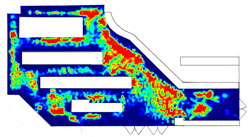ANALYTICS
SECTION ONE
SECTION TWO
Using Video Analytics Technology
To Optimize Secondary Displays in Stores
Understanding and influencing the shopper’s in-store decision process
has become critical for winning at retail. It involves mapping the in-store “path to purchase” and capturing why and how each “moment of truth” battle is won or lost.
Secondary displays represent perhaps the most effective way to gain visibility along the path of targeted shoppers - significantly impacting performance of a brand as well as category. Despite the fact that both manufacturers and retailers have a substantial financial stake in secondary displays such as end caps, due to a lack of a scalable means for measuring performance, secondary merchandising strategies are largely based on ad hoc rules with incomplete feedback on true impact or return on investment (ROI). Contrast that with marketing practices that are now standard in Internet retailing - thanks to the availability of click-through, page-view and other usage statistics.
The industry needs measurement tools that provide direct visibility into the shopper-decision process and enable shopper-centered metrics for improving every retail touch-point. Traditional research methods such as observation and survey methods are subjective, expensive, and under-sampled; therefore, they are not scalable. There is an urgent need for automation in the process of gathering rich shopper data to have a scalable measurement solution for optimizing retail.
A recent technology breakthrough has led to the development of an in-store measurement platform that fills the need for automatically capturing shopper behavior data. The patented video analytics technologies evolved from R&D spanning over a decade through funding from government agencies such as the Department of Defense, Department of Homeland Security, and the National Science Foundation.
The in-store measurement platform is set up without interfering with store operations. The sensors are configured to merge with the retail environment. The process involves installation of unobtrusive video sensors to cover the areas of interest in the store. Servers in the backroom of the store then process or “mine” the video streams in real time using proprietary software that converts video into rich data on shopper behavior and demographics.
The measurement process itself is totally anonymous, and doesn’t require any personal data from shoppers. In effect, software (instead of people) can now continuously “watch” in-store video to provide a wealth of statistical data on shopper behavior and demographics.
The Video Analytics platform for capturing in-store behavior in relation to displays offers the potential to bring the Internet-type metrics to brick-and-mortar retailing. The availability of the behavioral response data enables the development of a systematic framework for evaluating and optimizing secondary displays objectively. Data from millions of shopping trips and over a large set of displays allows for an understanding of the variations for display types and different factors that impact their performance. A suite of shopper metrics and advanced analytics can be employed to enable a comprehensive and holistic understanding of shopper behavior in relation to the displays.
Video Analytics can help in measuring all aspects of how secondary displays work for particular categories and brands; for example, % volume, path-to-purchase funnel metrics, impact of product, location, types of promotion, pricing, impact for different segments, etc. Here are some sample questions about secondary displays:
- How effective is a category/brand when on display?
- What % of shoppers actually shop a category’s end-cap, how long do they shop and do they actually make a purchase from the end-cap?
- Do End-Caps steal traffic from the aisle or help in attracting more shoppers into the aisle?
- How does relative placement (before/after) from the main aisle impact display performance?
- What is the optimal price point for a product when on display?
- How does a category’s end cap perform vs. other end caps? What is the role of product type on display performance?
- Which displays are more effective for a category -end cap, lobby, in-aisle and racetrack displays?
- Which categories are most effective on displays during key holidays?
- What is the optimal display configuration and design - vertical vs. horizontal, variety vs. pack-out, etc. for a category? Do displays with multiple products perform better?
- What is the role of adjacent departments on display performance?
Video Analytics can provide a deep and objective understanding of key factors that impact the performance of end caps and other secondary displays and help develop a “play book” for optimizing secondary merchandising.
This essay was written by Dr. Rajeev Sharma, Founder and CEO of VideoMining, a leading provider of shopper marketing insights using technology-based in-store measurement and analytics. It was excerpted from the book, “The Essentials of Shopper Technology.” For more information: www.videomining.com.
Click on the LinkedIn logo to join the new Shopper Technology Institute Discussion Group
SECTION THREE

